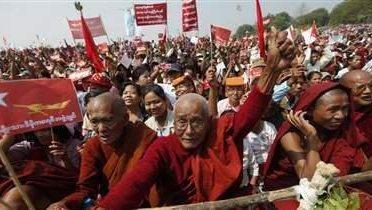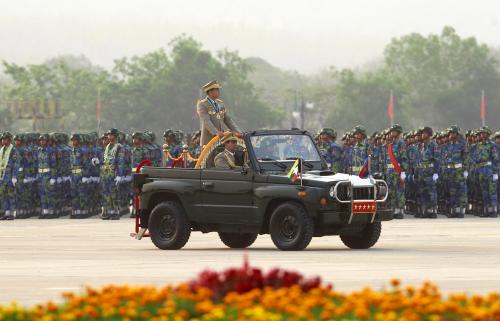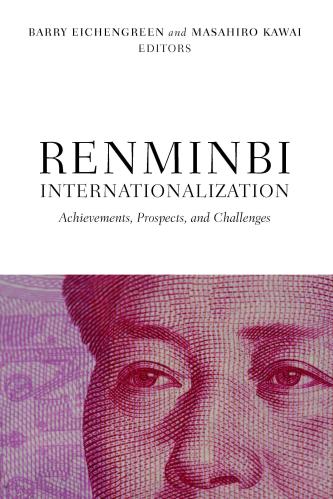Barack Obama will be the first sitting U.S. President to visit Burma/Myanmar since the country gained its independence in 1948. The visit has important implications for U.S. foreign policy toward China and for U.S. foreign assistance to countries in transition from authoritarian to democratic rule.
If anyone had said a year ago to the best foreign policy analysts in China that President Obama would be visiting Myanmar in November 2012, the reaction would have been total disbelief. The same reaction would have come from most Asian experts. Myanmar’s president, Thein Sein, in a near-miraculous collaboration with opposition leader Aung San Suu Kyi, has made the impossible into a reality.
For China, Obama’s imminent Southeast Asia visit is a signal that the “rebalancing toward Asia” strategy that was a hallmark of Obama’s first term will remain a top priority in his second. The countries Obama will visit—Thailand, Myanmar and Cambodia—are considered by Beijing to be “China-friendly” neighbors. Yingluck’s government has rejuvenated Thailand’s relations with Beijing after a period of turmoil. China was Myanmar’s “best friend” during the two decades Myanmar was ruled by General Than Shwe. Cambodia saved China from a major diplomatic embarrassment when it ardently defended China’s position on the South China Sea issue at the ASEAN foreign ministers’ meeting this past July. Regardless of what Washington claims to be its peaceful aims, Obama’s visit to these three countries as his first post-election foreign trip will inevitably fuel anxiety that America’s rebalancing toward Asia is at least partially, if not completely, about curtailing China’s regional influence.
Among the three countries, Obama’s visit to Myanmar will be the one watched most intently by China due to three distinct concerns. One is the evolution of U.S. policy toward Myanmar, especially how rapidly the U.S. moves to eliminate sanctions, ramp up aid to strengthen democratic institutions, and promote foreign direct investment by American companies. A second is any threat to the completion in 2013 of the dual gas and oil pipelines across Myanmar from the Indian Ocean to Yunnan Province in China. A third is the unresolved fate of the Myitsone dam, a large hydroelectric power dam that is under construction on the Irawaddy River in Myanmar. One of President Thein Sein’s early moves was to suspend construction of this Chinese financed and built project designed to export electricity to China. Pressure from the United States might persuade Thein Sein’s government—supported by Aung San Suu Kyi’s opposition party—to terminate not only this project but other hydroelectric dams that China wants Myanmar to build in order to supply China with the energy it needs to fuel its rapidly growing economy. Since President Thein Sein’s inauguration in March 2011, Myanmar has jumped from a pro-China tilt to an ostensibly non-aligned position vis-à-vis the world’s super powers. Any further movement by Myanmar away from China and toward the United States during Obama’s visit will ring alarm bells in Beijing with potentially serious consequences for U.S.-China relations.
The Obama visit to Southeast Asia does, however, complicate the policy challenge of keeping U.S.-China relations on an even keel as China’s economic and political power rises and the global role of the United States remains constrained by domestic problems.
This is not to say, of course, that the United States should prioritize China’s feelings over its own policy objectives in Myanmar. The Obama visit to Southeast Asia does, however, complicate the policy challenge of keeping U.S.-China relations on an even keel as China’s economic and political power rises and the global role of the United States remains constrained by domestic problems.
If President Obama could step beyond his “bubble” and beyond the main streets during his visit to Myanmar next Monday, he would find himself in neighborhoods much like those he ran through while growing up in Jakarta in the 1970s. In some ways, the democratic transition underway in Myanmar today represents a bigger leap than the transitions in East Europe and the former Soviet Union 20 years ago or the transitions in the Middle East that began two years ago. It certainly represents a much bigger leap than the democratic transition that began in Indonesia in 1998.
How the United States can best support Myanmar’s transition is no simple matter and its track record in supporting other transitions is mixed at best. In Indonesia, for example, millions of U.S. tax dollars have been spent since 1998 to strengthen Indonesia legislature and build a first class judicial system. Yet today Indonesia’s legislature is arguably the single biggest obstacle to progress in the country and its judicial system appears to be more corrupt than it was in 1998. Now Congress more than the Obama administration seems eager to allocate millions of U.S. tax dollars to fix Myanmar’s legislative and judicial systems, with the same kinds of assistance used in Indonesia.
Another example is the peace process in Myanmar, the country’s existential challenge. Norway has rushed in to be the lead donor in helping Thein Sein’s government end the insurgencies of a dozen ethnic minorities that started within days of the nation’s independence and have never been resolved. Despite its admirable expertise and its best intentions, some of Norway’s early moves have been ham-handed. Now the United States with a rather dubious record of peace building is starting to weigh in.
The main challenge for the United States in designing a sensible foreign aid program for Myanmar, however, is simply how to “do no harm” at a moment when Myanmar is drowning in offers of foreign aid. The best and brightest in every aid agency in the world are flocking to Myanmar determined to make a difference. With no experience in managing such a range of donors, including international NGOs, and an understandable reluctance to say no to visitors offering aid, senior officials in the Myanmar government are being diverted from the crucial tasks of making and implementing policies. In short, there is a risk that Obama’s visit will raise expectations that the Myanmar government will be unable to meet, which could contribute to some big bumps in the road ahead for the country.
The Brookings Institution is committed to quality, independence, and impact.
We are supported by a diverse array of funders. In line with our values and policies, each Brookings publication represents the sole views of its author(s).










Commentary
Op-edObama in Burma
November 16, 2012